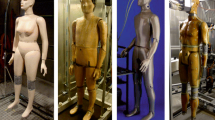Abstract
Tens of different sorts of thermal manikins are employed worldwide, mainly in the evaluation of clothing thermal insulation and thermal environments. They are regulated thermally using simplified control modes. This paper reports on the implementation and validation of a new thermoregulatory control mode for thermal manikins. The new control mode is based on a multi-segmental Pierce (MSP) model. In this study, the MSP control mode was implemented, using the LabVIEW platform, onto the control system of the thermal manikin ‘Therminator’. The MSP mode was then used to estimate the segmental equivalent temperature (t eq) along with constant surface temperature (CST) mode under two asymmetric thermal conditions. Furthermore, subjective tests under the same two conditions were carried out using 17 human subjects. The estimated segmental t eq from the experiments with the two modes and from the subjective assessment were compared in order to validate the use of the MSP mode for the estimation of t eq. The results showed that the t eq values estimated by the MSP mode were closer to the subjective mean votes under the two test conditions for most body segments and compared favourably with values estimated by the CST mode.










Similar content being viewed by others
References
Cheong KWD, Yu WJ, Kosonen R, Tham KW, Sekhar SC (2006) Assessment of thermal environment using a thermal manikin in a field environment chamber served by displacement ventilation system. Build Environ 41:1661–1670
de Dear R, Arens E, Zhang H, Oguro M (1997) Convective and radiative heat transfer coefficients for individual human body segments. Int J Biometeorol 40:141–156
Dufton A (1936) The equivalent temperature of a warmed room. J IHVE 4:227–229
Fanger PO (1970) Thermal comfort: analysis and applications in environmental engineering. Danish Technical, Copenhagen
Foda E, Sirén K (2011a) A new approach using Pierce two-node model for different body parts. Int J Biometeorol 55(4):519–532
Foda E, Sirén K (2011b) Dynamics of human skin temperatures in interaction with different indoor conditions, Proceedings of Roomvent 2011–12th international conference on air distribution in rooms. Trondheim, Norway
Foda E, Almesri I, Awbi HB, Sirén K (2011) Models of human thermoregulation and the prediction of local and overall thermal sensations. Build Environ J 46:2023–2032
Gagge AP, Stolwijk JAJ, Nishi Y (1971) An effective temperature scale based on a simple model of human physiological regulatory response. ASHRAE Trans 77(1):247–262
Hansen R, Elliott C, Vijayakumar V, Zink W (2007) National Instruments LabVIEW: a programming environment for laboratory automation and measurement. J Assoc Lab Autom 12(1):17–24
Hodgdon J, Beckett M (1984) Prediction of percent body fat for U.S. navy men and women from body circumferences and height. Reports No. 84–11 and 84–29, Naval Health Research Center, San Diego, CA
Holmér I (2004) Thermal manikin history and applications. Eur J Appl Physiol 92:614–618
Holmér I, Nilsson H, Bohm M, Norén O (1999) Equivalent temperature in vehicles-conclusions and recommendations for standard, CABCLI seminar dissemination of results from EQUIV-project, pp 89–94.
ISO (1985) Thermal environments–Instruments and methods for measuring physical quantities, Standard ISO 7726–1985 (E). International Organization of Standardization, Geneva
ISO (2007) Ergonomics of the thermal environment–estimation of the thermal insulation and water vapor resistance of a clothing ensemble, Standard ISO 9920:2007(E). International Organization of Standardization, Geneva
Madsen T, Olesen B, Reid K (1986) New methods for evaluation of the thermal environment in automotive vehicles. ASHRAE Trans 92(1B):38–54
McCullough E (2005) The use of thermal manikins to evaluate clothing and environmental factors. Elsevier Ergon B Ser 3:403–407
Melikov A, Zhou H (1999) Comparison of methods for determining t eq under well-defined conditions, CABCLI seminar dissemination of results from EQUIV-project, pp 41–52
Nilsson H (2004) Comfort climate evaluation with thermal manikin methods and computer simulation models. PhD thesis ISBN 91-7045-703-4
Nilsson H (2007) Thermal comfort evaluation with virtual manikin methods. Build Environ 42:4000–4005
Nilsson H, Holmér I, Bohm M, Norén O (1999) Definition and theoretical background of the equivalent temperature, CABCLI seminar dissemination of results from EQUIV-project, pp 31–40
Oliveira AVM, Gaspar AR, Qunitela DA (2008) Measurements of clothing insulation with a thermal manikin operating under the thermal comfort regulation mode: comparative analysis of the calculation methods. Eur J Appl Physiol 104:679–688
Quintela DA, Gaspar AR, Borges C (2004) Analysis of sensible heat exchanges from a thermal manikin. Eur J Appl Physiol 92:663–668
Sakoi T, Tsuzuki K, Kato S, Ooka R, Song D, Zhu S (2007) Thermal comfort, skin temperature distribution, and sensible heat loss distribution in the sitting posture in various asymmetric radiant fields. Build Environ 42:3984–3999
Tanabe S, Arens E, Bauman F, Zhang H, Madsen T (1994) Evaluating thermal environments by using thermal manikin with controlled skin surface. ASHRAE Trans 100(1):39–48
Wyon DP, Sandberg M (1990) Thermal manikin prediction of discomfort due to displacement ventilation. ASHRAE Trans 96(1):67–75
Wyon DP, Larsson S, Forsgren B, Lundgren I (1989) Standard procedures for assessing vehicle climate with a thermal manikin; SAE Paper 89004
Acknowledgement
The authors acknowledge the financial support kindly provided by Aalto University MIDE project.
Author information
Authors and Affiliations
Corresponding author
Rights and permissions
About this article
Cite this article
Foda, E., Sirén, K. A thermal manikin with human thermoregulatory control: Implementation and validation. Int J Biometeorol 56, 959–971 (2012). https://doi.org/10.1007/s00484-011-0506-6
Received:
Revised:
Accepted:
Published:
Issue Date:
DOI: https://doi.org/10.1007/s00484-011-0506-6




